 |
| |
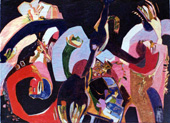
| Untitle 1974, oil on canvas cm 50x70 |
|
Luciana
Cicogna was born in Venice in 1949.
She was drawn to her vocation as an artist early in life,
nurtured by her father who was a well-known interior decorator
and restorer. Here she acquired skills working with Venetian
lacquer and copied floral arrangements from the paintings
of the 18th century. She also experimented more independent
and personal forms.
Her art studies continued, first at the Istituto d’Arte
and then at the Accademia in Venice, graduating in 1970 under
Giuseppe Santomaso.
Her early artistic output was shaped by her search for a stylisation
and simplification of the imagery of naturalist elements through
an expressiveness based prevalently on pure chromatic values.
|
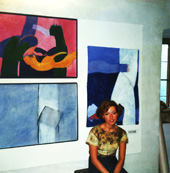
| Summer Accademy, Salisbury (Austria) 1975 |
|
She began to frequent the artistic milieu, coming into contact
with exponents of Venetian Spatialism and in particular with
Mario De Luigi, and whose courses she attended in 1975 at
the Salzburg Academy in Austria.
Her experience with De Luigi served to deepen the accents
of her abstract language through what was now becoming a progressive
detachment from references or allusions related to the natural
world, in order to attain greater formal independence and
an invented freedom of the imagination.
|
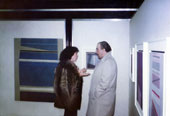
| Solo exibition, Traghetto Gallery, Venice 1978 |
|
Luciana
Cicogna began, meanwhile, to participate in exhibitions centred
on the experiments of the young artists of her generation.
She took part in the annual collective shows at the Bevilaqua
La Masa Foundation in 1975 and followed this up with the Foundation’s
shows in 1977 and 1978. A year earlier, she had her first featured
exhibition at the Galleria Incontro in Vicenza. In 1976 she
collaborated with a group of artists at a collective painting
event held in the Swiss Pavilion of the Biennale International
Exhibition of the Arts in Venice.In 1978, the Galleria il Traghetto
in Venice invited her to hold a personal show, exhibiting a
new series of works in which the spatial structure utilized
larger chromatic surfaces, geometrically subdivided to reduce
them and achieve a certain formal simplification quite close
to the contemporary proposals of the nuova pittura or “new
painting” style. |
|
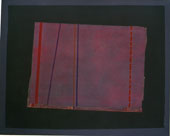
| Memory 1, 1981, acrylic on canvas cm 80x100 |
|
That
same year – together with a group of colleagues –
she founded the -movement called laboratorio-area with the idea
of publicizing and gaining recognition for certain more advanced
experiences of feminine creativity. The group held exhibitions
in Venice at the Galleria Nuovo Spazio.
The artist took part in successive showings at the Bevilacqua
La Masa Foundation, receiving gift prizes in 1979, 1982 and
1983, and winning a study bursary in 1984. Luciana Cicogna became
acquainted with the critic Giuseppe Marchiori who took a real
interest in her work and in 1981 wrote the introduction to the
catalogue of her show at the Galleria Fumagalli in Milan.
In this period her works were still in the area of abstraction,
but of a more contemplative and interior vision, and followed
the requirements of her intense lyrical reflection, through
which, citing Giuseppe Marchiori, “there appear images
of extreme purity, of a lyric character that express themselves
through a colouristic musicality of simple tones, of mysterious
humility and of an intimate harmony”.
.
In 1980 she was invited to a summer meeting of artists at Izlake
(Lubiana) and took part in the group’s exhibitions Immagine-Immaginario
with shows in Venice and Verona - Carlo Gentili being the curator.
. |
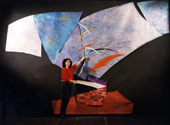
| Scene painting by teatro 7 - Venice, 1985 |
|
Towards
the mid-1980s, her painting decanted into a free development
of vast chromatic modulations, rhythmically scanned by more
ethereal and splendid scores, symbolically referring to the
realm of earth and sky, in a conception that rethreads allusive
elements of a fantastic cosmology. They are purely imagined
“landscapes”, but intensely evocative and elegant
analogies of perceptive and conceptual orders. These invented
forms arise from an introspective search in the world of nature,
wrought through both phenomenal and emotional evocations and
likenesses.
Luciana presented the results of this research in 1984 at
the 2° Biennale cittŕ di Bilione (Veneto), at the
exhibition i prossimi venturi, “the newcomers”,
featuring new artists emerging on the Veneta Art scene.
In 1985 she designed the sets for the spectacle celebrating
the poet Ferdinando Clamieri, curated by Theatre 7 in Venice. |

| 6 young Artist from Venice, 1986, Art Gallery department, Tulane University, New Orleans, Louisiana U.S.A |
|
In
the same year, for the Bevilacqua La Masa Foundation she took
part in the exchange exhibition organised at San Antonio (Texas)
and in New Orleans (Louisiana); in 1986 in Groningen (Holland)
and at the Istituto italiano di cultura in Amsterdam.
Over the next ten years she placed work in various collective
shows in various cities throughout Italy.
In this period her language rediscovered and renewed archetypes
of a mythical dimension depicting elements and metaphors of
surrealism conceived as a transfiguration of the natural world.
The symbols and allegories of a private cosmos emerge from the
plains and threads weaving her imaginative pattern,
consisting of intriguing allusions (heart, butterfly, moon, fragments of drawings of her sons)
charged with story-like fascination.
In 1993 the artist won a purchase award at the La Colomba/Galleria Naviglio Competition.
In 1994 she held a personal show at the Galleria Meeting at Mestre entitled "Fabulae" -
curated by Dino Marangon - exhibiting a group of collage and watercolours echoing a fabled vision
of the world of nature and of existence, fragmented signs, traces on which the symbology of
evocative impression gathers formal items of splendid poetic subtlety.
|
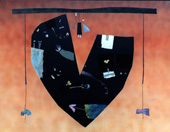
| Untitled 1995, acrylicon canvas cm 100x130 |
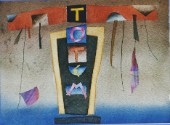
| Totem 1992, water color cm23x31 |
|
Through
particularly refined work, the artist developed her spatial
perspective, which increasingly became anchored to a coloured
lyricism projecting formal profiles on the canvas along with
evanescent bodies and phantasmagoric, dream-like presences.
In 1996, thanks to the philosopher Massimo Donŕ, Cicogna’s
paintings were presented in a joint exhibition at the Riviere
Gallery of Mirano (Venice) with those of Silvestro Lodi. The
exhibition entitled Crossed Gazes offered the occasion to approach
the work of the two painters from an analytic and speculative
perspective.
In 2000, the Italian Cultural Institute of Vienna invited the
artist to an exhibition hosting the protagonists of new artistic
trends in Italy.
In the years 2002/2003 Cicogna’s works were displayed
in the itinerant exhibitions La donna e l’Arte in Alpe
Adria in various cities throughout Hungary, Slovenia, Croatia
and Austria.
In 2002 the artist organised her own exhibition entitled “Nell’infinito
il colore”, which was presented by Diego Collovini at
the Multigraphic Gallery of Venice. |
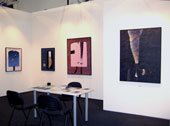
| Arte Padova 2006, XVII market exibition of Contemporary Art |
|
In
2005, two exhibitions of Cicogna’s paintings were hosted
by Toni Toniato at the Incontri Gallery in Bassano and the
Arkč Gallery in Venice. The artist also subscribed
to the 13 x 17 www.padiglioneitalia exhibition which took
place in the Church of San Gallo in Venice. The same exhibition
was subsequently hosted in other parts of Italy.
Cicogna’s latest works were represented with a personal
stand at the Fiera di Padova, Padua Trade Fair in 2005 and
2006.
In the context of an innovative approach to lyrical abstraction,
Luciana Cicogna’s standard style soon acquired a new
meaning in an artistic process of fantastic motivations filled
with subtle yet ravishing naturalistic and poetic allusions
January
2007 |
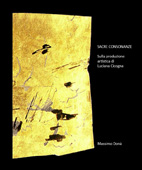
2009 "Sacred consonances" Perl'A Art Gallery - Venice |
2009 – An exhibition at the Perl'A Art Gallery in Venice presented by the philosopher Massimo Dona' and featuring a cycle of works whose main element consisted of a material formed in gilt layers.
The aim here was to convey the original nature of a light-form, in the sense of the sacredness of the original mystery from which creativity springs.
Dona' 's philosophical analysis shed light on the significance of a quest to express "the indecipherable" through a novel abstraction – by experimenting with the various modes of a graphic chromatic lyricism of evocative musical resonance.
|
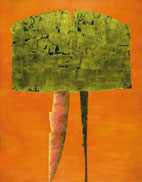
Oroalbero 2011,
gold leaf and acrylic on canvas
cm 70x50 |
The artist set out on a quest for formal simplification through the symbolic absoluteness of the figure of the tree - or better, of the tree in its graphic expression permeated by gold-painted background matter. The subject of the "OROALBERO", goldtree, is the most comprehensive sign of an idea of the incorruptibility of nature or - if you wish - of the necessity to re-establish its native utility as the absolute value of life. The fruit of this experience was exhibited in 2011 in a personal showing at the Galleria La Roggia in Pordenone, and in the 2012 "sguardo agli artisti veneziani" (outlook on Venetian artists) at Palazzo Bembo, Venice.
Since 2012 this symbology of nature has been picked out through the displaying of the materials... types of wood and of bark, utilized both as explicit recourse to the world of nature and as further formal resolutions.
These materials take on ever growing importance in the work, becoming no longer residual traces but suggestive bodies of a physical dissolution, drawing from these stimuli a different meaning intended to restore to the creative instance the primary state of a lyricism founded on the rhythm itself of the existence of things and of their value in the experience of time and of the world.
In 2013 the artist was invited to the important "Tabula rasa" exhibition at the Galleria d'Arte moderna e contemporanea at San Dona' di Piave (Veneto).
|
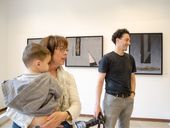
2014 Luciana with her grandchild Achille and the artist Ignacio Llamas, at the exhibition "Natura Naturans" on the island of S.Servolo, Venice |
Art Gallery Arkè - Venice
25.10.14 - 20.12.14
Natura Naturans - PDF of the exhibition at San Servolo island, Venice, maggio 2014
|
|
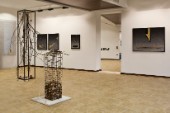
Natura Naturans Exhibition, S.Servolo Island, Room 1, Luciana Cicogna and Barbara Pelizzon
|
In 2014 the artist was invited to exhibit at the international exhibition on the subject "Natura Naturans" on the Island of San Servolo, Venice, with a series of works, executed between 2012 and 2014, based on the idea of ecology in progress, placing on the surface elements taken from the vegetal sphere and from vectorial forms, prickles, points, signs of a natural alphabet descriptive in its refined use of auric matter. That same year she held a personal show at the Galleria Arkč in Venice, presenting a cycle of paintings entitled "Della Natura Prima" (Of Prime Nature), curated by Toni Toniato.
|
|
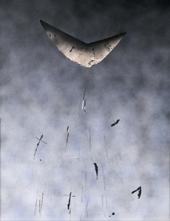
War Moon '915-'918, 2017 - silver leaf and acrylic on canvas cm 130x100
|
In 2017 she took part in the collective "Moderno/Contemporaneo", (Modern/Contemporary) presented at the Galleria Bugno in Venice and in 2018 he is invited to the group exhibition "Pittura di Guerra 1915/1918", (Paintings of War 1915/1918), at Palazzo Frisacco, Tolmezzo (UD), later transferred to villa Brandolini, Pieve di Soligo (TV) and curated by the critic Dino Marangon. There she exhibited a work featuring - among signs of desolation and death referring to that period of war - the image of a lunar segment, the only sign of light amid buried hopes and indelible ruins.
|
|
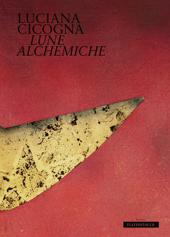
|
The motif of undulating lunar segments becomes the main iconic feature of her lyric abstractions, marked by fragments of the astro lost in space, dazzling luminescences of shipwrecked matter, by now in the emptiness. A similar subject is found in her most recent cycle of paintings that for the first time has been shown in 2018 at the Galleria Flavio Stocco in Castelfranco Veneto (TV), curated by Stefano Cecchetto entitled "Alchemic Moons".
|
|
|
At the Arkč Gallery she presents his personal exhibition: Alchemic Moons, a path marked by the poetics of his recent works that investigate the theme of a still time, suspended between dream and reality.
These 'Moons' present themselves in sequence, like a free suite of evocative fragments that form an architecture of thought: suspended, because they are illusory, but at the same time present with their metaphysical gravity.
A gravity which, however, dissolves within the fascination of those new moons swaying in space, agile and ductile, in a sort of aerial installation that refers to Calder's 'furniture'. These new three-dimensional "inventions" of hers move at the rhythm of a spontaneous tremor, shaken by the wind or lulled by a serene sea, like fragile poetic gondolas.
Suspended moon - 2019
Golden and silver leaf on polyethylene
Music: Chopin - Notturno Op.9 N.1
|
|
|